Each Flower Meaning
We do it all the time. We surprise someone with a bunch of bright yellow flowers to cheer them up.
We declare our fervent passion with two-dozen velvety roses. We sense the personalities of different flowers and intuitively choose one over another to fit our mood or the occasion.
But did you know that associating certain flowers with different meanings is an age-old art form?
The Japanese call it Hanakotoba, and King Charles II brought it to Sweden from Persia in the 17th century.
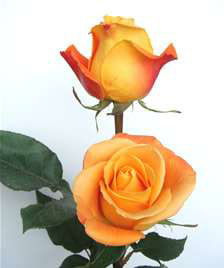
Floriography; a fancy name for the language of flowers was coined in the Victorian era, and while its original translations may have shifted over time, the notion that through flower symbolism we can express what we want to say (and may not be able to speak out loud) still holds true.
From the origin of a flowers name to its distinctive characteristics and rich mythology, flowers are infused with symbolism and meaning.
This Teleflora Flower Meaning Guide is designed to unravel these hidden mysteries, uncover these floral gems and open you up to a whole new language; the language of flowers.
Enjoy discovering each flower meaning.
You can also learn of roses and their meaning.
For poems about red roses check: roses are red poems.
Flower Name and Meanings
Alstromeria
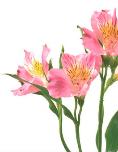
Resembling a miniature lily, alstroemeria, often called the Peruvian Lily or Lily of the Incas, was named after its discoverer, Baron Claus von Alstromer, a Swedish baron who collected the seeds on a trip to Spain in 1753.
Today, this popular flower can be found in a range of colors from white to golden yellow, orange to apricot, pink to red, lavender and purple. Symbolizing friendship and devotion, the alstroemeria's leaves grow upside down, with the leaf twisting as it grows out from the stem, so that the bottom is facing upwards, much like the twists, turns and growth of our friendships.
Amaryllis meaning.
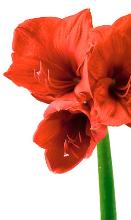
Legend has it that the amaryllis - the stunning red flower we've come to associate with the holidays began as a shy, timid nymph.
Amaryllis fell deeply in love with Alteo, a shepherd with Hercules' strength and Apollo's beauty, but her affections were unrequited.
Hoping that she could win him over by bestowing upon him the thing he desired most - a flower so unique it had never existed in the world before - Amaryllis sought advice from the oracle of Delphi.
Following his instructions, Amaryllis dressed in maiden's white and appeared at Alteo's door for 30 nights, each time piercing her heart with a golden arrow.
When at last Alteo opened his door, there before him was a striking crimson flower, sprung from the blood of Amaryllis's heart.
With this romantic - albeit tragic - tale as its beginning, it's not surprising that today the amaryllis has come to symbolize pride, determination and radiant beauty.
Anemones meaning.
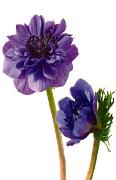
The name anemone comes from the Greek word for "windflower."
According to Greek mythology, the anemone sprang from Aphrodite's tears as she mourned the death of Adonis.
Thought to bring luck and protect against evil, legend has it that when the anemone closes its petals, it's a signal that rain is approaching.
Still other mythology connects the anemone to magical fairies, who were believed to sleep under the petals after they closed at sunset. Perhaps it's because of this magical and prophetic tales that today in the language of flowers, anemones represent anticipation.
Anthuriums meaning

With their open, heart-shaped flowers and tropical disposition, it's no wonder that anthurium have come to symbolize hospitality.
Also known as the Flamingo Flower, Boy Flower, Painted Tongue and Painters Palette because of their distinctive shape and color.
the name anthurium comes from Greek, meaning "tail flower." Exotic and compelling, with bold, typically red flowers and shiny, dark green foliage, anthurium, like the hospitality they represent, are long- lasting and irresistibly beautiful.
Aster

With their wildflower beauty and lush texture, asters have long been considered an enchanted flower.
In ancient times, it was thought that the perfume from their burning leaves could drive away evil serpents.
Today, they're known as a talisman of love and a symbol of patience. Also known as starworts, Michaelmas daisies or Frost flowers, the name aster is derived from the Greek word for "star" and its star like flowers can be found in a rainbow of colors: white, red, pink, purple, lavender and blue, with mostly yellow centers.
The September birth flower, asters also hold the honor of being the 20th wedding anniversary flower.
Bird of Paradise meaning.

Bearing an unmistakable resemblance to a brightly colored bird in flight, bird of paradise are native to south Africa and represent joyfulness and (not surprisingly) paradise itself.
Also known as Crane flowers, they are distinctive and striking, spectacularly shaped like a bird's beak and plumage. Bird of Paradise are the 9th wedding anniversary flower.
The September birth flower, asters also hold the honor of being the 20th wedding anniversary flower.
Bouvardia meaning.
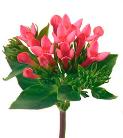
Named after Charles Bouvard, the personal physician to Louis XIII and the superintendent of the Royal Gardens in Paris, modern varieties of bouvardia have names such as Pink Luck, Albatross and Royal Katty.
Their star-like flowers grow in clusters on thin, branching stems, like small flower bouquets in soft shades of pink, white, yellow, salmon and red.
With a delicate scent and feminine appearance, in the language of flowers, bouvardia represent enthusiasm.
Blue Flowers meaning.
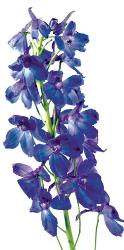
Blue flowers hold a special significance in the language of flowers and apparently,given their long standing popularity a special place in our hearts as well. Whether it's the deep blue petals of an iris or the light blue lace of hydrangea, the wildflower beauty of blue star anemone and commelina or the dramatic arch of blue delphinium, blue flowers offer a cooling antidote to our over-stimulated lives and anxious days.
A color that is known to hold universal appeal, blue plays a significant role in many cultures'religious rituals and ceremonies. It's said that the Western tradition of a bride wearing something blue is tied to the color's symbolism of faithfulness and loyalty.
In its dark, regal tones, blue can express trustworthiness, confidence, intelligence and unity, which explains why it's frequently the color of police uniforms, why the blue "power suit" is an icon of the business world and why winners of competitions receive blue ribbons. And yet, in its softer hues, blue can embody the uplifting spirit of a sunny sky or soothing ocean,perhaps explaining why so many of us choose blue flowers when we want to send a message of calming beauty, tranquility and peace.
Carnations meaning

With a history that dates back more than 2,000 years, it's not surprising that carnations are rich with symbolism,mythology and even debate.While some scholars suggest that their name comes from the word "corone" (flower garlands) or "coronation" because of its use in Greek ceremonial crowns, others propose that it's derived from the Latin "carnis"(flesh) referring to the flower's original pinkish-hued color or "incarnacyon" (incarnation), referring to the incarnation of God-made flesh.
Today, carnations can be found in a wide range of colors, and while in general they express love, fascination and distinction, virtually every color carries a unique and rich association. White carnations suggest pure love and good luck, light red symbolizes admiration, while dark red represents deep love and affection. Purple carnations imply capriciousness, and pink carnations carry the greatest significance, beginning with the belief that they first appeared on earth from the Virgin Mary's tears,making them the symbol of a mother's undying love.
Worn on Mother's Day, Teacher's Day, St.Patrick's Day (in green, of course) and at weddings, this hardy, sweetly fragrant flower is also the state flower of Ohio, the January birth flower and the 1st wedding anniversary flower.
Chrysanthemum meaning.
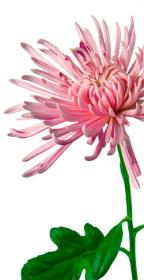
With a history that dates back to 15th century B.C., chrysanthemum mythology is filled with a multitude of stories and symbolism.
Named from the Greek prefix "chrys-" meaning golden (its original color) and "anthemion" meaning flower, years of artful cultivation have produced a full range of colors, from white to purple to red. Daisy-like with a typically yellow center and a decorative pompon, chrysanthemums symbolize optimism and joy.
They're the November birth flower, the 13th wedding anniversary flower and the official flower of the city of Chicago. In Japan, there's even a "Festival of Happiness" to celebrate this flower each year.
A symbol of the sun, the Japanese consider the orderly unfolding of the chrysanthemum's petals to represent perfection, and Confucius once suggested they be used as an object of meditation. It's said that a single petal of this celebrated flower placed at the bottom of a wine glass will encourage a long and healthy life.
Daffodil Narcissus meaning.
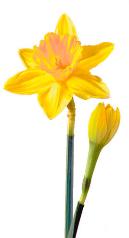
Symbolizing rebirth and new beginnings, the daffodil is virtually synonymous with spring. Though their botanic name is narcissus, daffodils are sometimes called jonquils, and in England, because of their long association with Lent, they're known as the "Lent Lily."
Lore connecting the daffodil to not only a sign of winter's end but a lucky emblem of future prosperity is found throughout the world. In Wales, it's said if you spot the first daffodil of the season, your next 12 months will be filled with wealth, and Chinese legend has it that if a daffodil bulb is forced to bloom during the New Year, it will bring good luck to your home.
The March birth flower and the 10th wedding anniversary flower, a gift of daffodils is said to ensure happiness. But always remember to present daffodils in a bunch, the same legends that associate this cheerful flower with good fortune warn us that when given as a single bloom, a daffodil can foretell misfortune.
Delphinium meaning.
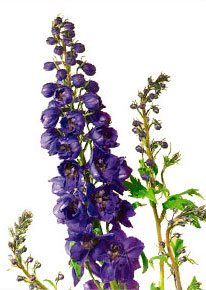
Derived from the Greek word "delphis" meaning dolphin,delphinium are also commonly knownas larkspur.
Other names include Lark's Heel, Lark's Claw and Knight's Spur. Used by Native Americans and European settlers to make blue dye, it's believed that the most ancient use of delphinium flowers was for driving away scorpions.
The July birth flower, these lush,dolphin-shaped flowers symbolize anopen heart and ardent attachmentand convey a feeling of lightness and levity.
Freesia meaning.
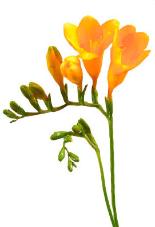
Named after the German physician Friedrich Heinrich Theodor Freese,freesia, with their bell-shaped blooms and sweet, citrus scent are among the most popular fragrant flowers. And, while in most cases the white variation of a flower is the most fragrant, in the case of freesia, the pink and red varieties are actually more highly scented.
With their wiry stems and delicate blooms, it's not surprising that one of the most popular freesia varieties is named Ballerina.
The 7th wedding anniversary flower,in the language of flowers, freesia are said to symbolize innocence and friendship.
Gladiolus meaning.
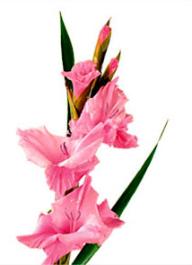
Named for the shape of their leaves,gladioli, from the Latin word "gladius,"meaning sword,have a history than spans from Africa to the Mediterranean.
Symbolizing strength and moral integrity,gladioli also represent infatuation, with a bouquet conveying to a recipient that they pierce the giver's heart with passion.
Striking and colorful with towering stems, this August birth flower and 40th wedding anniversary flower evoke the drama of Roman gladiators.
Heather meaning.
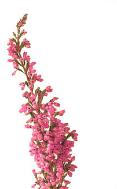
Heather's scientific name, "Calluna vulgaris," comes from the Greek "Kallune," meaning "to clean or brush," and the Latin "vulgaris," meaning "common,"as heather twigs were once used for making brooms.
Native to Ireland, Scotland, Scandinavia, Russia and North America, heather branches are also said to have been used to make baskets, rope, bedding, as thatch for roofs and even to flavor beer or tea.
Today, it's the beautiful heather flowers in colors ranging from white to pink, purple and red that draw our attention. Symbolizing admiration and good luck, heather is also believed have protective powers.
Hydrangea
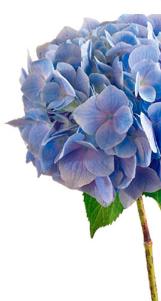
First discovered in Japan, the name hydrangea comes from the Greek "hydor," meaning water, and "angos," meaning jar or vessel.
This roughly translates to "water barrel," referring to the hydrangea's need for plenty of water and its cup shaped flower. With its wooden stems and lacy, star shaped flowers packed closely together in a pompom, the hydrangea's color ranges fromwhite to blue to pink and purple, determined by the acidity level of the soil.
There remains some debate over the hydrangea's symbolism with some connecting it to vanity and boastfulness (perhaps reflecting its abundance of petals and lavish, rounded shape) and others suggesting that a bouquet of hydrangea expresses the giver's gratefulness for the recipient's understanding.
Still others suggest it represents anything that's sincerely heartfelt. Despite this variation in flower meaning, there appears to be an overwhelming consensus that this 4th wedding anniversary flower possesses enduring grace and beauty.
Iris meaning.
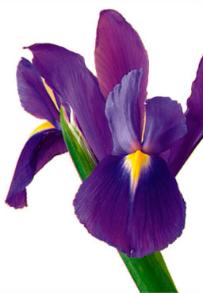
The iris's mythology dates back to Ancient Greece, when the goddess Iris, who personified the rainbow (the Greek word for iris), acted as the link between heaven and earth. It's said that purple irises were planted over the graves of women to summon the goddess Iris to guide them in their journey to heaven. Irises became linked to the French monarchy during the Middle Ages, eventually being recognized as their national symbol, the fleur-de-lis.
The February birth flower, the 25th wedding anniversary flower and the state flower of Tennessee, the iris's three upright petals are said to symbolize faith, valor and wisdom.
Lilac meaning
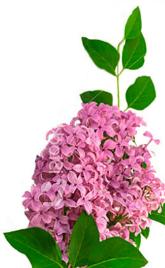
The story of lilac, according to Greek mythology, begins with a beautiful nymph named Syringa (lilac's botanical name).
Captivated by her beauty, Pan, the god of the forests and fields, chased Syringa through the forest.
Frightened by Pan's affections, Syringa escaped him by turning herself into an aromatic bush, the flower we now refer to as lilac.
The 8th wedding anniversary flower and the state flower of New Hampshire (symbolizing the hardy character of the Granite State's citizens), lilacs are frequently considered a harbinger of spring, with the time of their bloom signaling whether spring will be early or late.
In the language of flowers, purple lilacs symbolize the first emotions of love, while white lilacs represent youthful innocence.
Lily meaning
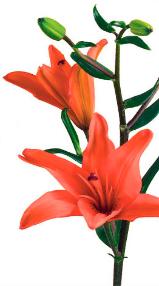
Dating as far back as 1580 B.C., when images of lilies were discovered in a villa in Crete, these majestic flowers have long held a role in ancient mythology.
Derived from the Greek word "leiron," (generally assumed to refer to the white Madonna lily), the lily was so revered by the Greeks that they believed it sprouted from the milk of Hera, the queen of the gods.
Lilies are known to be the May birth flower, and the 30th wedding anniversary flower.
While white lilies symbolize chastity and virtue and were the symbol of the Virgin Mary's purity and her role of Queen of the Angels, as other varieties became popular, they brought with them additional meanings and symbolism as well.
Peruvian lilies, or alstroemeria, represent friendship and devotion, white stargazer lilies express sympathy and pink stargazer lilies represent wealth and prosperity.
Symbolizing humility and devotion, lilies of the valley are the 2nd wedding anniversary flower.
As the flowers most often associated with funerals, lilies symbolize that the soul of the departed has received restored innocence after death.
Lisianthus meaning
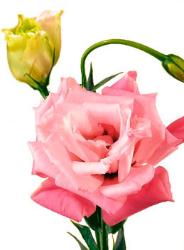
With a host of names,from Texas Bluebell to Prairie Gentian to Lira de San Pedro, lisianthus symbolize an outgoing nature. Native to Texas and Mexico, and descended from a North American wildflower, in their single- form variety, lisianthus may resemble tulips or poppies.
In their double form, they can take on the appearance of roses or peonies.
With wide ruffled, delicate petals and oval leaves, in colors ranging from white to pink, lavender to purple and bicolors such as blue-violet, it's said that lisianthus also symbolize appreciation.
Orchid meaning
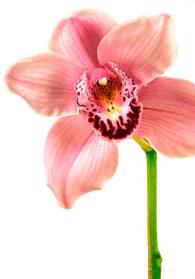
The most highly coveted of ornamental plants, the delicate, exotic and graceful orchid represents love, luxury, beauty and strength.
In ancient Greece, orchids were associated with virility. In fact, Greek women believed that if the father of their unborn child ate large, new orchid tubers, the baby would be a boy.
If the mother ate small orchid tubers, she would give birth to a girl.
During the Victorian era, orchid symbolism shifted to luxury, and today this sense of magnificence and artful splendor continues, with orchids representing rare and delicate beauty.
The 14th wedding anniversary flower, pink orchids convey pure affection, and the popular cattelya orchid represents mature charm.
Peony meaning
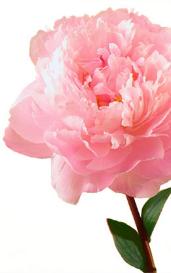
With a recorded history that dates back thousands of years, it's not surprising that even the mythology surrounding the origin of the peony has multiple versions.
One legend has it that the peony is named after Paeon, a physician to the gods, who received the flower on Mount Olympus from the mother of Apollo. And another tells the story of that same physician who was "saved" from the fate of dying as other mortals by being turned into the flower we know today as the peony.
The traditional floral symbol of China, the state flower of Indiana, and the 12th wedding anniversary flower, peonies are known as the flower of riches and honor.
With their lush, full, rounded bloom, peonies embody romance and prosperity and are regarded as an omen of good fortune and a happy marriage.
Poinsettia meaning

Also known as the Christmas Star and Christmas Flower, it's said that this winter flower's association with Christmas comes from a Mexican legend.
The story goes that a child, with no means for a grander gift, gathered humble weeds from the side of the road to place at the church alter on Christmas Eve.
As the congregation witnessed a Christmas miracle, the weeds turned into brilliant red and green flowers.
Named after Joel Roberts Poinsett, first United States ambassador to Mexico and the amateur botanist who introduced the plant to the U.S. in 1825, the poinsettia is also known as Mexican Flame Leaf, Winter Rose, Noche Buena and, in Turkey, Atakurk's Flower, because it was the favorite flower of Atakurk, the founder of modern Turkey.
While considered by the ancient Aztecs to be symbols of purity, in today's language of flowers, red, white or pink poinsettias, the December birth flower, symbolize good cheer and success and are said to bring wishes of mirth and celebration.
Queen Anne Lace meaning
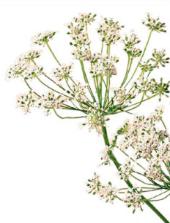
Legend has it that Queen Anne, the wife of King James I, was challenged by her friends to create lace as beautiful as a flower. While making the lace, she pricked her finger, and it's said that the purple red flower in the center of Queen Anne's Lace represents a droplet of her blood. Also called Wild Carrot (since Queen Anne's Lace is the wild progenitor of today's carrot), Bishop's Lace or Bird's Nest (for the nest like appearance of the bright white and rounded flower in full bloom), in the language of flowers, Queen Anne's Lace represents sanctuary
Ranunculus meaning
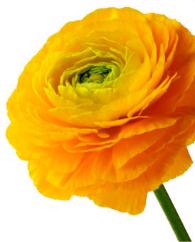
Native to Asia and celebrated for its medicinal properties as well as its bright beauty, the small camellia-like ranunculus ranges from white to pink, red to yellow to orange.
Also known as Buttercup and Coyote's Eyes, legend has it that the mythological Coyote was tossing his eyes up in the air and catching them when Eagle snatched them. Unable to see, Coyote created eyes from the buttercup.
In the language of flowers, a bouquet of ranunculus says,"I am dazzled by your charms."
Roses meaning
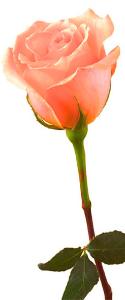
Long a symbol of love and passion, the ancient Greeks and Romans associated roses with Aphrodite and Venus, goddesses of love. Used for hundreds of years to convey messages without words, they also represent confidentiality.
In fact, the Latin expression "sub rosa" (literally, "under the rose") means something told in secret, and in ancient Rome, a wild rose was placed on the door to a room where confidential matters were being discussed.
Each color offers a distinct meaning: red, the lover's rose, signifies enduring passion; white, humility and innocence; yellow, expressing friendship and joy; pink, gratitude, appreciation and admiration; orange, enthusiasm and desire; white lilac and purple roses represent enchantment and love at first sight. The number of stems in a rose bouquet can also express specific sentiments.
The June birth flower and the 15th wedding anniversary flower, roses are also the national flower of the United States and the state flower of Georgia, Iowa, New York, North Dakota and the District of Columbia. And, not surprisingly, June the month so often associated with weddings is National Rose Month.
Snapdragon meaning
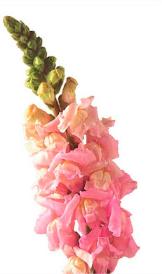
Derived from the Greek words "anti," meaning like, and "rhin," meaning nose, antirrhinum, the snapdragon's botanical name, is a fitting description of this snout- shaped flower.
It's said that the common name for this colorful flower comes from the snap it makes when the sides of the "dragon's mouth" are gently squeezed.
While their actual origin is unknown, it's believed that snapdragons were originally wildflowers in Spain and Italy.
Legend has it that concealing a snapdragon makes a person appear fascinating and cordial, and in the language of flowers, snapdragons are said to represent both deception (perhaps tied to the notion of concealment) and graciousness.
In the language of flowers, a bouquet of ranunculus says, "I am dazzled by your charms."
Statice meaning

Grown for both its colorful flowers and its everlasting calyx (the green leaf that encloses the flower bud), statice is also considered an herb, referred to as "sea lavender."
Statice is commonly used in dried flower arrangements as well as fresh bouquets.
Its botanical name is derived from the Greek word "limonium," meaning meadow, referring to the plants original habitat and likely why this versatile flower is also called marsh-rosemary.
With a misty and seafoam appearance (two more names associated with this wildflower-like plant), in the language of flowers, statice symbolizes remembrance.
Stock meaning
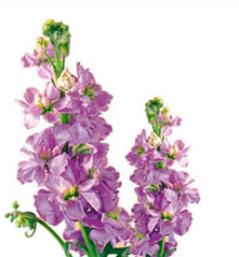
A symbol of happy life and contented existence, the stock flower, with its sweet, heady-scented blooms, is native to Southwestern Greece and the Mediterranean.
Typically found in white, pink, red or lilac, stock is also called gillyflower or Virginia stock.
Sunflower meaning

While their distinctive and brilliant appearance makes it easy to see why sunflowers have long held our fascination, when they were first grown in Central and South America, it was more for their usefulness (providing oil and food) than beauty. And perhaps this unique combination of striking beauty and utility is, in part, why sunflowers have appeared as such revered symbols throughout the ages.
It's said that the natives of the Inca Empire worshipped a giant sunflower, and that Incan priestesses wore large sunflower disks made of gold on their garments.
Images of sunflowers were found in the temples of the Andes mountains, and Native American Indians placed bowls of sunflower seeds on the graves of their dead. The Impressionist period of art is famous for its fascination with the sunflower, and this striking flower remains today a commonly photographed and painted icon of uncommon beauty.
The 3rd wedding anniversary flower and the state flower of Kansas, sunflowers turn to follow the sun. Their open faces symbolize the sun itself, conveying warmth and happiness, adoration and longevity.
Sweetpea meaning
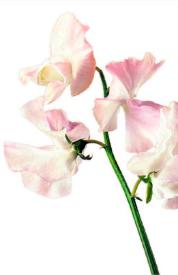
With its richly colored yet small, delicate flowers, the sweet pea's history can be traced back to 17th century Italy, when a Sicilian monk, Franciscus Cupani, sent its seeds to England.
Although that original sweet pea bore little resemblance to the flower we know today, when Harry Eckford, a Scottish nurseryman, crossbred the original flower, he created the colorful, ornamental and sweetly scented sweet pea we know today.
Ekford's varieties included the pink Dorothy Eckford, the lavender Lady Grisel Hamilton, the scarlet King Edward VII and perhaps his most famous, the Countess Spencer.
Meaning delicate or blissful pleasure in the language of flowers, this enchanting flower remains a favorite fragrant blossom.
Tulips

Originally from Persia and Turkey, tulips were brought to Europe in the 16th century, where they got their common name from the Turkish word for gauze (with which turbans were wrapped) - reflecting the turban- like appearance of a tulip in full bloom.
By the 17th century, the popularity of tulips, particularly in the Netherlands, became so great that the price of a single bulb soared to new heights, causing markets to crash and putting into motion "tulip mania."
Although different tulip colors carry distinct meanings - yellow tulips symbolizing cheerful thoughts, white conveying forgiveness and purple representing royalty - a Turkish legend may be responsible for the red tulip's symbolism.
The story goes that a prince named Farhad was love struck by a maiden named Shirin. When Farhad learned that Shirin had been killed, he was so overcome with grief that he killed himself - riding his horse over the edge of a cliff.
It's said that a scarlet tulip sprang up from each droplet of his blood, giving the red tulip the meaning "perfect love."
The 11th wedding anniversary flower, it's said that the tulips velvety black center represents a lover's heart, darkened by the heat of passion.
With the power to rival roses in their red variety and the sweet charm to express simple joy when yellow, it's no wonder that in addition to all its other symbolism, in the language of flowers, a tulip bouquet represents elegance and grace.
Flower Inspiration
The pessimist see the thorns and not the roses
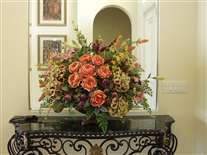
Flowers seem intended for the solace of ordinary humanity.
John Ruskin
If you've never been thrilled to the very edges of your soul by a flower in spring bloom, maybe your soul has never been in bloom.
Terri Guillemets
I wandered lonely as a cloud
That floats on high o'er vales and hills,
When all at once I saw a crowd,
A host, of golden daffodils;
Beside the lake, beneath the trees,
Fluttering and dancing in the breeze
Continuous as the stars that shine
And twinkle on the milky way,
They stretched in never-ending line
Along the margin of a bay:
Ten thousand saw I at a glance,
Tossing their heads in sprightly dance.
~William Wordsworth, 1804
I perhaps owe having become a painter to flowers.
Claude Monet
Flowers have spoken to me more than I can tell in written words.
They are the hieroglyphics of angels, loved by all men for the beauty of their character, though few can decipher even fragments of their meaning.
Lydia M. Child